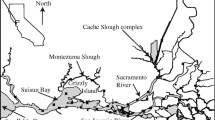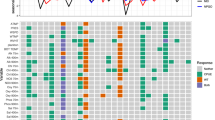Abstract
There is increasing scientific interest in studying the spatial distribution of species abundance in relation to environmental variability. Jellyfish in particular have received considerable attention in the literature and media due to regional population increases and abrupt changes in distribution. Jellyfish distribution and abundance data, like many biological datasets, are characterized by an excess of zero counts or nonstationary processes, which hampers their analyses by standard statistical methods. Here we further develop a recently proposed statistical framework, the constrained zero-inflated generalized additive model (COZIGAM), and apply it to a spatio-temporal dataset of jellyfish biomass in the Bering Sea. Our analyses indicate systematic spatial variation in the process that causes the zero inflation. Moreover, we show strong evidence of a range expansion of jellyfish from the southeastern to the northwestern portion of the survey area beginning in 1991. The proposed methodologies could be readily applied to ecological data in which zero inflation and spatio-temporal nonstationarity are suspected, such as data describing species distribution in relation to changes of climate-driven environmental variables. Some supplemental materials including an animation of jellyfish annual biomass and web appendices are available online.
Similar content being viewed by others
References
Agarwal, D. K., Gelfand, A. E., and Citron-Pousty, S. (2002), “Zero-Inflated Models with Application to Spatial Count Data,” Environmental and Ecological Statistics, 9, 341–355.
Antoch, J., and Huskova, M. (2001), “Permutation Tests in Change Point Analysis,” Statistics Probability Letters, 53, 37–46.
Barry, S. C., and Welsh, A. H. (2002), “Generalized Additive Modelling and Zero Inflated Count Data,” Ecological Modelling, 157, 179–188.
Barz, K., and Hirche, H. J. (2007), “Abundance, Distribution and Prey Composition of Scyphomedusae in the Southern North Sea,” Marine Biology, 151, 1021–1033.
Battisti, A., Stastny, M., Netherer, S., Robinet, C., Schopf, A., Roques, A., and Larsson, S. (2005), “Expansion of Geographic Range in the Pine Processionary Moth Caused by Increased Winter Temperatures,” Ecological Applications, 15, 2084–2096.
Bi, H., Ruppel, R. E., and Peterson, W. T. (2007), “Modeling the Pelagic Habitat of Salmon off the Pacific Northwest (USA) Coast Using Logistic Regression,” Marine Ecology Progress Series, 336, 249–265.
Bond, N. A., Overland, J. E., Spillane, M., and Stabeno, P. (2003), “Recent Shifts in the State of the North Pacific,” Geophysical Research Letters, 30, 2183.
Brodeur, R. D., Decker, M. B., Ciannelli, L., Purcell, J. E., Bond, N. A., Stabeno, P. J., Acuna, E., and Hunt, G. L. J. (2008), “The Rise and Fall of Jellyfish in the Bering Sea in Relation to Climate Regime Shifts,” Progress in Oceanography, 77, 103–111.
Brodeur, R. D., Mills, C. E., Overland, J. E., and Shumacher, J. D. (1999), “Evidence for a Substantial Increase in Gelatinous Zooplankton in the Bering Sea, with Possible Links to Climate Change,” Fisheries Oceanography, 8, 296–306.
Brodeur, R. D., Sugisaki, H., and Hunt, G. L. J. (2002), “Increases in Jellyfish Biomass in the Bering Sea: Implications for the Ecosystem,” Marine Ecology Progress Series, 233, 89–103.
Chan, K. S., Stenseth, N. C., Lekve, K., and Gjøsæter, J. (2003), “Modeling Pulse Disturbance Impact on Cod Population Dynamics: The 1988 Algal Bloom of Skagerrak, Norway,” Ecological Monographs, 73, 151–171.
Chiogna, M., and Gaetan, C. (2007), “Semiparametric Zero-Inflated Poisson Models with Application to Animal Abundance Studies,” Environmetrics, 18, 303–314.
Ciannelli, L., Bailey, K., Chan, K. S., and Stenseth, N. C. (2007), “Phenological and Geographical Patterns of Walleye Pollock Spawning in the Gulf of Alaska,” Canadian Journal of Aquatic and Fisheries Sciences, 64, 713–722.
Cunningham, R. B., and Lindenmayer, D. B. (2005), “Modeling Count Data of Rare Species: Some Statistical Issues,” Ecology, 85, 1135–1142.
Decker, M. B., Brown, C. W., Hood, R. R., Purcell, J. E., Gross, T. F., Matanoski, J., Bannon, R. O., and Setzler-Hamilton, E. M. (2007), “Predicting the Distribution of the Scyphomedusa, Chrysaora quinquecirrha, in Chesapeake Bay,” Marine Ecology Progress Series, 329, 99–113.
Fox, C. J., O’Brien, C. M., Dickey-Collas, M., and Nash, R. D. M. (2000), “Patterns in the Spawning of Cod (Gadus morhua L.), Sole (Solea solea L.) and Plaice (Pleuronectes platessa L.) in the Irish Sea as Determined by Generalized Additive Modeling,” Fisheries Oceanography, 9, 33–49.
Frost, J. R., Jacoby, C. A., and Youngbluth, M. J. (2010), “Behavior of Nemopsis Bachei L. Agassiz, 1849 Medusae in the Presence of Physical Gradients and Biological Thin Layers,” Hydrobiologia, 645, 97–111.
Graham, W. M., Martin, D. L., and Martin, J. C. (2003), “In Situ Quantification and Analysis of Large Jellyfish Using a Novel Video Profiler,” Marine Ecology Progress Series, 254, 129–140.
Hare, S. R., and Mantua, N. J. (2000), “Empirical Evidence for North Pacific Regime Shifts in 1977 and 1989,” Progress in Oceanography, 47, 103–145.
Hu, Z., Qin, J., and Follmann, D. (2008), “Semiparametric Two-Sample Changepoint Model with Application to Human Immunodeficiency Virus Studies,” Journal of the Royal Statistical Society: Series C, 57, 589–607.
Huskova, M. (2004), Fields Institute Communications, 44, 273–291.
Lambert, D. (1992), “Zero-Inflated Poisson Regression, with an Application to Defects in Manufacturing,” Technometrics, 34, 1–14.
Liu, H., and Chan, K. S. (2008), “Constrained Generalized Additive Model with Zero Inflated Data,” Technical Report 388, The University of Iowa, Department of Statistics and Actuarial Science.
— (2010), “Introducing COZIGAM: An R Package for Unconstrained and Constrained Zero-Inflated Generalized Additive Model Analysis,” Journal of Statistical Software, 35(11), 1–26.
Martin, T. G., Wintle, B. A., Rhodes, J. R., Kuhnert, P. M., Field, S. A., Low-Choy, S. J., Tyre, A. J., and Possingham, H. P. (2005), “Zero Tolerance Ecology: Improving Ecological Inference by Modelling the Source of Zero Observations,” Ecology Letters, 8, 1235–1246.
Musolin, D. L. (2007), “Insects in a Warmer World: Ecological, Physiological and Life-History Responses of True Bugs (heteroptera) to Climate Change,” Global Change Biology, 13, 1565–1585.
Mutlu, E. (2001), “Distribution and Abundance of Moon Jellyfish (Aurelia aurita) and Its Zooplankton Food in the Black Sea,” Marine Biology, 138, 329–339.
Perry, A. L., Low, P. J., Ellis, J. R., and Reynolds, J. D. (2005), “Climate Change and Distribution Shifts in Marine Fishes,” Science, 308, 1912–1915.
Purcell, J. E. (2005), “Climate Effects on Formation of Jellyfish and Ctenophore Blooms: A Review,” Journal of Marine Biological Association of UK, 85, 461–476.
— (2007), “Environmental Effects on Asexual Reproduction Rates of the Scyphozoan Aurelia labiata,” Marine Ecology Progress Series, 348, 183–196.
Purcell, J. E., Hoover, R. A., and Schwarck, N. T. (2009), “Interannual Variation of Strobilation of the Scyphozoan aurelia labiata in Relation to Polyp Density, Temperature, Salinity, and Light Conditions,” Marine Ecology Progress Series, 28, 207–217.
Raskoff, K. A., Purcell, J. E., and Hopcroft, R. R. (2005), “Gelatinous Zooplankton of the Arctic Ocean: In Situ Observations Under the Ice,” Polar Biology, 28, 207–217.
Ruiz-Cárdenas, R., Assunção, R. M., and Demétrio, C. (2009), “Spatio-Temporal Modelling of Coffee Berry Borer Infestation Patterns Accounting for Inflation of Zeroes and Missing Values,” Scientia Agricola, 66, 100–109.
Schwarz, G. (1978), “Estimating the Dimension of a Model,” The Annals of Statistics, 6, 461–464.
Stabeno, P. J., Bond, N. A., Kachel, N. B., Salo, S. A., and Schumacher, J. D. (2001), “On the Temporal Variability of the Physical Environment of the South-Eastern Bering Sea,” Fisheries Oceanography, 10, 81–98.
Stauffer, G. (2004), NOAA Protocols for Groundfish Bottom Trawl Surveys of the Nation’s Fishery Resources, U.S. Dep. Commer., NOAA Tech. Memo. NMFS-F/SPO-65, 205 p.
Suchman, C. L., and Brodeur, R. D. (2005), “Abundance and Distribution of Large Medusae in Surface Waters of the Northern California Current,” Deep-Sea Research II, 52, 51–72.
Tong, H. (1990), Non-Linear Time Series: A Dynamical System Approach, Oxford: Oxford University Press.
Vandenbroek, J. (1995), “A Score Test for Zero Inflation in a Poisson-Distribution,” Biometrics, 51, 738–743.
Warton, D. I. (2005), “Many Zeros Does Not Mean Zero Inflation: Comparing the Goodness-of-Fit of Parametric Models to Multivariate Abundance Data,” Environmetrics, 16, 275–289.
Welsh, A. H., Cunningham, R. B., Donnelly, C. F., and Lindenmayer, D. B. (1996), “Modelling the Abundance of Rare Species: Statistical Models for Counts with Extra Zeros,” Ecological Modelling, 88, 297–308.
Wood, S. N. (2003), “Thin Plate Regression Splines,” Journal of the Royal Statistical Society: Series B, 65, 95–114.
— (2006), Generalized Additive Models, an Introduction with R, London: Chapman and Hall.
Wynn, R. B., Josey, S. A., Martin, A. P., and Yésou, P. (2007), “Climate-Driven Range Expansion of a Critically Endangered Top Predator in Northeast Atlantic Waters,” Biology Letters, 3, 529–532.
Author information
Authors and Affiliations
Corresponding author
Electronic Supplementary Material
Below is the link to the electronic supplementary material.
Rights and permissions
About this article
Cite this article
Liu, H., Ciannelli, L., Decker, M.B. et al. Nonparametric Threshold Model of Zero-Inflated Spatio-Temporal Data with Application to Shifts in Jellyfish Distribution. JABES 16, 185–201 (2011). https://doi.org/10.1007/s13253-010-0044-4
Accepted:
Published:
Issue Date:
DOI: https://doi.org/10.1007/s13253-010-0044-4




